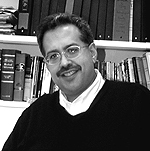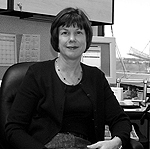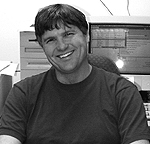 Henry
Levin
received his Ph.D. in the lab of Howard Schachman at the University
of California, Berkeley, in 1987. He did his postdoctoral work at Johns
Hopkins Medical School before joining the NICHD Laboratory of Molecular
Genetics in 1993. He is now a senior investigator in the Laboratory of
Eukaryotic Gene Regulation.
Henry
Levin
received his Ph.D. in the lab of Howard Schachman at the University
of California, Berkeley, in 1987. He did his postdoctoral work at Johns
Hopkins Medical School before joining the NICHD Laboratory of Molecular
Genetics in 1993. He is now a senior investigator in the Laboratory of
Eukaryotic Gene Regulation.
My interests lie in the proliferation of retroelements, the most medically important class of which are the retroviruses. The genetic complexity of the host vertebrates for retroviruses, however, complicates the study of particle assembly, reverse transcription, nuclear entry, and integration into chromosome.
Our approach to understanding these events is to study retrotransposons, a family of elements closely related to retroviruses that offer a significant advantage: They exist in yeast, a host that can be studied using the powerful techniques of molecular genetics.
The retrotransposon we study is the Tf1 element of fission yeast, Schizosaccharomyces pombe. Like retroviruses, Tf1 encodes a protease, reverse transcriptase, and integrase. We have developed a genetic assay for Tf1 transposition that has allowed us to study several aspects of its propagation.
One of our early results was perhaps the most surprising. Although all long terminal repeat retroelements were thought to initiate reverse transcription from specific tRNA primers, we showed that tRNAs are not essential primers of reverse transcription. We found that Tf1 undergoes an unusual mechanism of self-primed reverse transcription that defines a new family of retroelements. In place of a tRNA primer, the first 11 bases of the Tf1 mRNA anneal to the primer binding site, and a nucleolytic cleavage at the 12th base allows the first 11 ribonucleotides to prime reverse transcription.
A series of genetic and biochemical experiments identified a complex structure in the Tf1 mRNA that is essential for priming. Despite the novelty of this mechanism, we identified structural features within the self-priming mRNA that bear surprising similarity to sequences in the mRNA of retroviruses. The similarities of the self-priming mRNA to RNAs of many other retroelements have motivated us to continue our analysis of the self-priming mechanism.
One of the principal goals of our research is to identify host functions that are necessary for retrotransposition. As we characterize these basic features of cellular biology, we can simultaneously identify potential targets for antiviral therapies. We screened randomly mutagenized strains of S. pombe and identified genes that are necessary for transposition. Much of our effort is focused on Nup124p, a nuclear pore factor that is required for the nuclear import of Tf1. Strains with mutations in nup124 showed normal growth rates and exhibited no defects in the nuclear import of other nuclear proteins or in the nuclear export of poly(A) mRNA.
The specificity of this import pathway for Tf1 is likely due to the direct interaction between Nup124p and Gag that we detected. The contribution of Nup124p to the nuclear import of Tf1 bears significant similarity to the nuclear transport of HIV in that the Vpr protein of HIV mediates the import of HIV via an interaction with specific nuclear pore factors. This particular similarity suggests there may be common properties of large viral complexes that require a specialized form of nuclear import, and we are continuing our analysis of Tf1 import to test this possibility.
In addition, we are exploring our collection of mutant strains for evidence of other genes that contribute to the import of Tf1.
 Charles
Rabkin received his M.D.
from Brown University (Providence, R.I.) in 1981 and his M.Sc. in epidemiology
from the London School of Hygiene and Tropical Medicine in 1988. He trained
in internal medicine at the University of Colorado in Denver. He was an
Epidemic Intelligence Service officer and medical epidemiologist at the
Centers for Disease Control and Prevention before joining NCI in 1989
and is now a senior investigator in the Viral Epidemiology Branch,
NCI.
Charles
Rabkin received his M.D.
from Brown University (Providence, R.I.) in 1981 and his M.Sc. in epidemiology
from the London School of Hygiene and Tropical Medicine in 1988. He trained
in internal medicine at the University of Colorado in Denver. He was an
Epidemic Intelligence Service officer and medical epidemiologist at the
Centers for Disease Control and Prevention before joining NCI in 1989
and is now a senior investigator in the Viral Epidemiology Branch,
NCI.
My research combines epidemiologic approaches to cancer in human populations with the evolving tools of molecular genetics. My primary interest is the molecular mechanisms of HIV-associated cancers, focusing on non-Hodgkin’s lymphoma and Kaposi’s sarcoma. AIDS-related cancers are an important model for investigating the role of specific mutations in carcinogenesis.
With colleagues in NCI’s Laboratory of Genetics, we demonstrated that HIV- infected-but-lymphoma-free individuals frequently harbored circulating lymphocytes with the t(8;14) chromosomal translocation characteristic of Burkitt’s lymphoma. Translocation prevalence increased with duration of HIV infection, and aberrant clones could persist for many years without evolution into non-Hodgkin’s lymphoma. We also found that these individuals did not have increased prevalence of follicular (that is, non-AIDS- related) lymphoma-associated t(14;18) translocations, demonstrating the specificity of HIV’s effect.
Having identified somatic mutation as an early event, I am now concentrating on abnormalities in advanced HIV infection that may control the rate of tumor development.
With collaborators in the NCI-Frederick Cancer Research and Development Center, we have also examined germ-line mutations and recently found that a common polymorphism in the SDF-1 chemokine gene strongly increases lymphoma risk in AIDS, whereas a variant of the chemokine receptor gene CCR5 is highly protective. Because the SDF-1 variant is four times as common in whites as in blacks, these data may explain racial differences in AIDS-lymphoma risk that our group and others previously reported.
My Kaposi’s sarcoma studies have examined the neoplastic nature of this disorder. In collaborations with several laboratories, we found that Kaposi’s sarcoma tumors appear to derive from clonal replication of a single cell. By combining microdissection with the clonality assay, we then found that spindle cells from multiple Kaposi’s sarcoma lesions from the same patient appeared to be clonally related, suggesting the disease derived and disseminated from a single cell. These experiments have been based on the X-linked androgen receptor (HUMARA) clonality assay, and I am currently attempting to validate and extend these findings with more robust techniques.
My other major interest is in infectious mechanisms in gastrointestinal cancers. Helicobacter pylori infection is associated with both gastric cancer and nonmalignant duodenal ulcer disease. The reasons for these divergent clinical outcomes are not clear, but the gastric physiological response is influenced by the severity and anatomical distribution of H. pylori–induced gastritis. Our group is focusing on polymorphisms in the genes regulating inflammation and immunity as possible determinants of gastric cancer and its precursors.
Another endeavor is to better determine the long-term prognosis of hepatitis C infection—currently a difficult proposition. The risk of liver cancer in particular is controversial. In collaboration with NIDDK, we ascertained the health outcomes after 45 years’ follow-up of initially healthy hepatitis C–seropositive young men. Liver-related morbidity and mortality were low, suggesting that the risk of progressive disease may be less than is currently perceived.
Heavy use of alcohol and other substances may alter this natural history, however, and we are extending these studies with a unique collection of sera and liver biopsy specimens of hepatitis C–seropositive injection drug users followed for as long as 25 years.
Infection-related cancers are fruitful areas for research of fundamental mechanisms of carcinogenesis. Better understanding of these processes should help in the development of targeted interventions for cancer prevention.
 Juan
Rivera received his Ph.D.
from the Catholic University of America (Washington, D.C.)in 1990 and
did his postdoctoral work in the Arthritis and Rheumatism Branch of NIAMS,
where he is now a senior investigator and head of the Signal Transduction
Group.
Juan
Rivera received his Ph.D.
from the Catholic University of America (Washington, D.C.)in 1990 and
did his postdoctoral work in the Arthritis and Rheumatism Branch of NIAMS,
where he is now a senior investigator and head of the Signal Transduction
Group.
My interests are in the area of receptors that bind the crystallizable fragment of an antibody (Fc receptors) and their role in inflammation, with a focus on how these receptors transduce signals that result in gene expression. The underlying objective is the discovery of the receptor-proximal molecules that link the immune complex activation of Fc receptors to expression of particular cytokine genes. I see this as an important step in understanding how Fc receptors contribute to the process of inflammation in health and disease. Hopefully, these studies will facilitate development of better therapeutics that target those mediators that contribute to inflammatory disease, without affecting the production of others that may be beneficial for recovery.
Fc receptors can either activate or inhibit cell effector functions. The subfamily of activating receptors share in common the Fc receptor gamma signaling subunit. My colleagues and I study the molecular signals initiated by the activating Fc receptor with high affinity for immunoglobulin E (IgE) that is expressed on mast cells and is involved in allergy and inflammation. We focus on identifying IgE Fc receptor–activated signaling molecules that could modulate cytokine gene expression.
We found that selected members of the protein kinase C family participate in IgE Fc receptor induction of the early response genes c-fos and c-jun and cause a selective induction of IL-2 and IL-6. In addition, we discovered that another protein kinase C isoform selectively phosphorylates the IgE Fc receptor and that this event is important in creating an appropriate surface for the binding and activation of Syk, the kinase critical to propagating signaling and mast cell effector function. We observed that in the absence of this protein kinase C–mediated phosphorylation there is a loss of cytokine production. These studies demonstrated that Fc receptors use different members of the protein kinase C family to either selectively or generically influence the production of cytokines.
We are now investigating how the formation of macromolecular signaling complexes contributes to the regulation and specificity of Fc receptor cytokine gene expression. Much of our effort is focused on Vav, a guanine nucleotide exchange factor that is selectively expressed in hematopoietic cells. Our progress in this area relied on the development of a versatile gene expression system based on the Semliki Forest virus that can be used to overexpress or restore proteins of interest in most primary and immortalized cell lines tested. We found that Vav modulates selected cytokine expression in mast cells. We also found that Vav moves from the cytosol to detergent-insoluble plasma membrane domains, or rafts, where activated IgE Fc receptors also reside. Inhibition of the redistribution of Vav results in inhibition of c-jun NH2-terminal kinase activity, an activity required for expression of selected cytokines. In addition, we found that Vav co-immunoprecipitates with the raft-localized scaffold protein linker of activated T cells (LAT) in mast cells. In recent collaborative studies, we found that LAT-null mast cells show ablation or decreased production of most cytokines tested. Thus, macromolecular signaling complexes are seemingly comprised of constituents that individually influence selected genes but collectively affect many.
We are currently investigating how Fc receptors engage the macromolecular signaling complexes and are trying to determine the importance of each signaling complex constituent in cytokine gene expression. We expect to explore the role of the constituent proteins in inflammatory disease in animal models.
 Sandra
Swain received her M.D. from the
University of Florida in Gainesville in 1980. She did an internal medicine
residency at Vanderbilt University in Nashville, Tenn., and an oncology
fellowship at NCI, where she supervised breast cancer clinical trials
until 1988. After serving as director of the Comprehensive Breast Center
at Georgetown University’s Lombardi Cancer Center (Washington, D.C.)
and then as medical director for Salick Health Care, Inc., she returned
to NCI, where she is deputy branch chief of the Medicine Branch and a
senior investigator in the Developmental Therapeutics Department.
Sandra
Swain received her M.D. from the
University of Florida in Gainesville in 1980. She did an internal medicine
residency at Vanderbilt University in Nashville, Tenn., and an oncology
fellowship at NCI, where she supervised breast cancer clinical trials
until 1988. After serving as director of the Comprehensive Breast Center
at Georgetown University’s Lombardi Cancer Center (Washington, D.C.)
and then as medical director for Salick Health Care, Inc., she returned
to NCI, where she is deputy branch chief of the Medicine Branch and a
senior investigator in the Developmental Therapeutics Department.
My primary area of interest is breast cancer clinical research. I have designed, implemented, participated in, analyzed, and published findings from numerous clinical trials, ranging from Phase 1 to large, multicenter Phase 3 trials. Crucial to my understanding of translational research issues was my work on a project in the laboratory of Marc Lippman that led to the discovery of pleiotropin, which is implicated in angiogenesis.
I have participated in several national cooperative group trials and am currently on the breast cancer committee of the National Surgical Breast and Bowel Project (NSABP). I am also national principal investigator for the node-positive NSABP clinical trial (NSABP B-30), which is accruing 4,000 patients at the rate of 105 patients a month. The trial has three treatment arms and is designed to determine the effect of docetaxel on survival and quality of life in women who are node-positive at breast cancer diagnosis. This study will capture the effect of menopause by including and following women who are premenopausal at diagnosis. As national PI, I review ongoing trials, with particular attention to toxicities.
Earlier in my career, I supervised an NCI study of the effect of chemotherapy before local therapy in patients with locally advanced breast cancer, a study whose results led to a larger version of the trial in the NSABP B-18. I plan to continue research in this area to evaluate new agents that could be used in the context of pre- and posttreatment biopsy for gene discovery and protein expression analysis.
The cardiotoxicity of some anticancer agents is another of my research interests. I participated in the design, implementation, conduct, and data analyses of two national, multicenter, placebo-controlled, randomized studies that showed that dexrazoxane, an iron-chelating agent, could decrease cardiotoxicity in breast cancer patients taking doxorubicin.
These findings were the basis for approval of the drug by the Food and Drug Administration in 1995, and dexrazoxane remains the only drug approved for cardioprotection in oncology. I plan to continue working in the area of cardiotoxicity.
My service on the FDA’s Oncology Advisory Committee, as a member from 1994 to 1998 and continuing as a consultant, has provided invaluable understanding of the scientific and regulatory processes that underlie the determination of safety and efficacy of new therapeutic modalities. This experience will serve me well in my ongoing work in drug development and clinical trial design.
 David
Wink
received his Ph.D. in chemistry at the University of California, Santa
Barbara in 1985. Following a postdoctoral fellowship in biochemistry as
a National Research Service Award recipient at the Massachusetts Institute
of Technology in Cambridge, he joined the Laboratory of Comparative Carcinogenesis
at NCI-FCRDC as a staff fellow. In 1995, he joined NCI’s Radiation
Biology Branch, where he is now a senior investigator.
David
Wink
received his Ph.D. in chemistry at the University of California, Santa
Barbara in 1985. Following a postdoctoral fellowship in biochemistry as
a National Research Service Award recipient at the Massachusetts Institute
of Technology in Cambridge, he joined the Laboratory of Comparative Carcinogenesis
at NCI-FCRDC as a staff fellow. In 1995, he joined NCI’s Radiation
Biology Branch, where he is now a senior investigator.
My general aim is to elucidate the chemical reactions of small redox molecules and their importance in different physiological and cellular mechanisms. Since coming to NCI, I have been particularly interested in the role of nitric oxide (NO) in regulatory mechanisms as well as in pathophysiological conditions. Appreciation of the importance of NO in biology has increased exponentially, making it one of the fastest growing fields in biomedical research.
My early work concentrated on elucidating different chemical mechanisms of NO and how these reactions might be involved in different pathophysiological conditions. We began to define the chemistry of NO in toxicological and carcinogenic mechanisms and to identify different molecular targets that are modified by NO and related chemical species. My current research interests center on the chemistry and biochemistry of free radicals in cellular and tissue damage and how these reactions can be modulated. We have explored some of the basic chemical mechanisms of reactive oxygen species (ROS) formation from metal-peroxide interactions as well as reactions involved with NO and the effect these reactions have on biological systems.
One important discovery was the selective inhibition of specific DNA repair enzymes by NO. These mechanisms were shown to prevent the repair of DNA lesions induced by alkylating agents as well as ROS. In these studies, we have catalogued and defined the effects of the interaction of different radicals on cytotoxic mechanisms. For instance, NO serves to protect mammalian cells from hydrogen peroxide and xanthine oxidase-mediated cytotoxicity. Yet in prokaroytes, NO in combination with peroxide and xanthine serves as an impressive bactericidal agent. Correlation of the different effects NO has on the cytotoxicity of other agents with the chemical mechanisms has been described in what I refer to as the "chemical biology of nitric oxide."
This concept has provided a guide to understanding the free radical chemistry of NO in biological systems (D.A. Wink and J.B. Mitchell. "The chemical biology of nitric oxide: insights into regulatory, cytotoxic, and cyto-protective mechanisms of nitric oxide. Free Radic. Biol. Med. 25:434-456, 1998). We have collaborated with several groups to explore the role of NO in infectious diseases, ischemic reperfusion injury, and neurological disorders.
We became particularly interested in the effect of NO on increasing the toxicity of chemotherapeutic agents and radiation. This has resulted in a major new challenge–to apply what has been learned in the chemical biology of NO to improving cancer treatment. We have investigated the use of free radicals to modulate modalities of cancer treatment. Nitric oxide can radiosensitize hypoxic cells. In addition, recent results show that NO dramatically enhances the cytotoxicity of some chemotherapeutic drugs including melphalan and cisplatin. A major objective is to selectively target tumor sites as opposed to normal tissue. We have taken two approaches. The first is the use of exogenous chemical agents that can specifically target tumors and deliver NO. Second, because there are reports that certain tumors may exhibit nitric oxide synthase (NOS) activity, we have begun to explore different strategies of inducing NOS directly in tumors, thereby providing a source of NO to the tumor directly.
Throughout this
research, we have had to explore different methods to deliver the NO redox
chemistry to cellular models as well as in vivo. This has required the
development of an analytical repertoire and synthetic systems that mimic
redox reactions. Using a variety of analytical methods, we can determine
the production of NO, RNOS, and ROS derived from different stimuli of
the immune system. We can then develop a corresponding chemical model
that can be used to treat cells and probe different molecular aspects
of redox chemistry. We have been mapping the chemical effects on molecular
targets to understand in vivo mechanisms of NO and to define the redox
chemistry required to improve therapeutic outcomes.
![]()